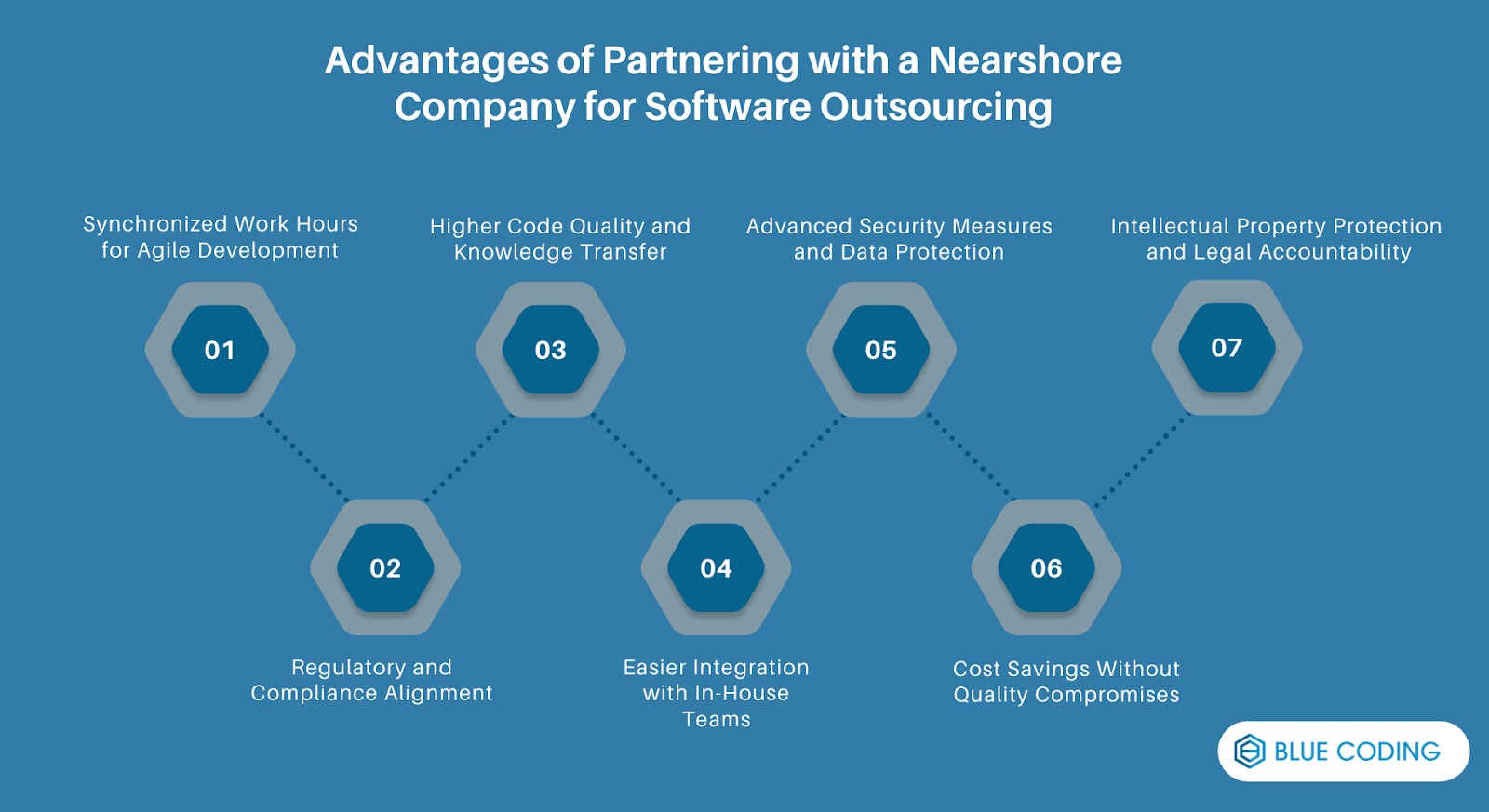 News
News
Outsourcing has always been a strategic way for businesses to optimize costs and access specialized talent, but the approach is evolving. Companies are shifting away from offshore outsourcing to nearshore partnerships for better communication, cultural alignment, and real-time collaboration. According to a report by Grand View Research, the nearshore outsourcing market is projected to grow at a CAGR of 8.5% from 2024 to 2030, driven by the increasing demand for high-quality yet cost-effective IT solutions. Businesses now recognize that nearshore companies offer the best balance between affordability and efficiency. In this blog, we’ll break down why nearshore outsourcing is gaining momentum, the benefits it brings to software development, and the common myths that might be holding companies back from making the switch.
What Exactly Is A Nearshore Company?
A nearshore outsourcing company is a specialized service provider that offers businesses access to skilled professionals in neighboring or nearby countries, ensuring smoother collaboration due to geographic proximity, similar time zones, and cultural compatibility. Unlike offshore outsourcing, which involves hiring teams from distant locations, nearshore outsourcing minimizes challenges related to communication delays, language barriers, and coordination issues. These companies typically focus on IT services, software development, customer support, and business process outsourcing, leveraging cost efficiency while maintaining high-quality standards. Many businesses prefer nearshore outsourcing because it allows for real-time interaction, easier travel for on-site visits, and better alignment with local regulations. Also, these companies invest in talent pools that are well-versed in industry-specific requirements, ensuring that outsourced teams can integrate seamlessly with in-house operations. For example, a U.S. company might partner with a nearshore outsourcing firm in Mexico, Colombia, or Argentina to take advantage of lower labor costs without sacrificing collaboration efficiency. Furthermore, nearshore providers often adopt agile development methodologies, allowing them to deliver flexible, iterative solutions tailored to clients' evolving needs. This combination of cost savings, skilled labor, and operational convenience makes nearshore outsourcing an attractive strategy for businesses looking to scale efficiently while maintaining control over their projects.
Global Distribution of Nearshore Destinations Based on Dataset Analyzed:
Advantages of Partnering with a Nearshore Company for Software Outsourcing

Synchronized Work Hours for Agile Development:
Nearshoring ensures overlapping time zones, allowing real-time collaboration with minimal delays. This is particularly beneficial for agile software development, where frequent sprint reviews, daily stand-ups, and quick feedback loops are crucial. Unlike offshore outsourcing, where time zone differences might delay issue resolution by an entire day, nearshore teams can respond instantly, leading to faster development cycles and fewer bottlenecks.
Regulatory and Compliance Alignment:
Nearshore companies operate within legal frameworks that are often more aligned with your business region. For example, Latin American countries working with U.S. businesses are familiar with data protection laws. This reduces the legal risk associated with software development, especially for industries like fintech and healthcare, where compliance is critical.
Higher Code Quality and Knowledge Transfer:
Nearshore teams often have education systems and training programs influenced by U.S. or European standards. This means developers are not just skilled in coding but also familiar with best practices like Test-Driven Development (TDD), CI/CD pipelines, and DevOps methodologies. Also, knowledge transfer is smoother due to fewer language barriers, enabling more effective documentation, training, and long-term software maintainability.
Easier Integration with In-House Teams:
Unlike offshore outsourcing, where cultural differences might impact work styles, nearshore developers often share similar work ethics, communication styles, and business etiquette. This fosters a more collaborative environment, making it easier to integrate external teams into your internal workflows. This is especially useful when scaling a software project, as nearshore teams can quickly adapt to in-house tools, management structures, and development practices.
Advanced Security Measures and Data Protection:
Security is a major concern in software outsourcing, and nearshore providers often comply with international cybersecurity standards. Many nearshore firms implement ISO 27001, SOC 2, and other security frameworks to ensure secure software development. Also, their geographic proximity allows for more straightforward auditing, on-site visits, and secure data exchange practices compared to offshore alternatives.
Cost Savings Without Quality Compromises:
Nearshoring provides a balanced cost-to-quality ratio. While offshore locations like India or the Philippines might offer cheaper labor, nearshore destinations deliver competitive pricing without sacrificing quality. Countries like Mexico, Argentina, and Colombia offer highly skilled developers at 30-50% lower costs than U.S. engineers while still maintaining high coding standards, making them a cost-effective yet reliable choice.
Intellectual Property (IP) Protection and Legal Accountability:
Nearshore companies operate in regions with stronger IP protection laws, reducing the risk of software piracy, theft of intellectual property, or unauthorized data usage. Many Latin American countries have trade agreements with the U.S. and EU that enforce strict IP regulations, ensuring businesses maintain ownership over their software products without legal loopholes. Also, resolving disputes is easier since these countries follow international arbitration frameworks.
Myths About Partnering with Nearshore Software Solutions Companies and Why They Are Wrong
Myths often prevent businesses from considering nearshoring as a viable solution, but the reality is that nearshore software companies offer a balance of affordability, quality, and efficiency that makes them one of the best options for outsourcing software development.
Myth 1: Nearshore Companies Lack Technical Expertise.
One common misconception is that nearshore software companies do not have the same level of technical expertise as onshore or offshore teams. This is far from the truth. Many nearshore countries have strong education systems with a focus on STEM fields, producing highly skilled developers. Countries like Argentina, Mexico, and Colombia have well-established tech hubs where engineers are trained in cutting-edge technologies such as AI, blockchain, and cloud computing. Also, nearshore companies follow international coding standards, DevOps practices, and agile methodologies, making their technical expertise on par with, or even superior to, other outsourcing destinations.
Myth 2: Nearshore Outsourcing Is More Expensive Than Offshore.
Some businesses believe that nearshore hiring is not cost-effective compared to offshore outsourcing in Asia. While offshore development may have lower hourly rates, the hidden costs of offshore outsourcing, such as communication delays, quality control issues, and expensive rework, can make it more expensive in the long run. Nearshore companies offer competitive pricing while ensuring better collaboration, reducing miscommunications, and delivering higher-quality code. This balance between affordability and efficiency makes nearshore outsourcing a smart investment.
Myth 3: Language Barriers Make Communication Difficult.
A major concern about outsourcing is the potential language barrier, but nearshore companies often have developers who are fluent in English, especially those in Latin America working with U.S. clients. Many nearshore developers are bilingual or have been trained to communicate effectively in English, ensuring smooth collaboration. Unlike offshore teams in countries where English is not widely spoken, nearshore developers can engage in detailed technical discussions, preventing misunderstandings and improving workflow efficiency.
Myth 4: Time Zone Differences Still Cause Delays.
Some assume that nearshore hiring still comes with time zone misalignment, making it no different from offshore outsourcing. However, the reality is that nearshore teams operate in similar or overlapping time zones, allowing for real-time communication, instant feedback, and better workflow synchronization. This is a huge advantage in agile development, where quick iterations and daily stand-ups are necessary. Unlike offshore outsourcing, where a simple request might take 24 hours to process due to time differences, nearshore teams can respond immediately, reducing project delays.
Myth 5: Security Risks Are Higher in Nearshore Countries.
Another myth is that nearshore outsourcing comes with security risks, including weak intellectual property (IP) protection. However, many nearshore countries have strict cybersecurity regulations, data protection laws, and compliance standards such as ISO 27001 and SOC 2. Also, Latin American countries that have trade agreements with the U.S. and EU are bound by strong IP laws, ensuring that businesses maintain full ownership of their software products and sensitive data.
Myth 6: Nearshore Companies Can’t Handle Large-Scale Projects.
Some believe that nearshore companies are only suitable for small projects and cannot manage large-scale software development. This is false because many nearshore firms have extensive experience working with global enterprises and handling complex projects. Nearshore teams are equipped with enterprise-level solutions, cloud architecture expertise, and large-scale development capabilities, making them reliable partners for both startups and multinational corporations.
Hire Nearshore Developers With Blue Coding
Blue Coding is one of the pioneer companies when it comes to nearshore outsourcing to Latin America. Being in business for more than 10 years now, we have made it to the list of fortune 500 companies! Our team of tech consultants and developers ensure completion of all project milestones on time and continue to take feedback from the clients as we prioritize client satisfaction! If you're interested in nearshore staffing or staff augmentation, contact us and let's discuss your business goals on a free strategy call!




